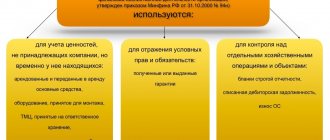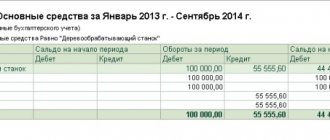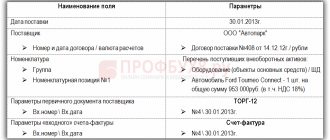Chart of accounts
Cash flow accounting is carried out in account 50 “cash” in the chart of accounts. This account is an active synthetic one and sub-accounts are usually opened for it, showing the cash flow in the context of:
- 50-1 “Cash desk of the organization” - to reflect cash transactions directly at the cash desk of the organization (issuance of money for household needs, travel expenses, etc.);
- 50-2 “Operating cash desk” - to reflect cash transactions carried out in separate divisions and areas of the enterprise (in shops, cafes, kiosks, etc.);
- 50-3 “Cash documents” - to reflect transactions with strict reporting forms, as well as other securities (stamps, vouchers, bills, etc.);
- other subaccounts, if necessary.
For each of the subaccounts, it is necessary to conduct analytics in the context of movement in each department.
Enterprise cash
Cash comprehensively covers the functioning of any enterprise at all stages of its life cycle: firstly, it is the authorized capital for starting activities; then - funds for the purchase of fixed and working capital; obtaining funds in the form of profit is the main goal of commercial organizations; Moreover, enterprises often cease their activities precisely because of a lack of funds and, as a consequence, loss of solvency. And these are just the main points regarding this topic.
Given the importance of funds, there is a need for a more detailed study of the theoretical foundations of their use. To do this, it is proposed to answer the following questions:
- Formulate the definition of money.
- Consider options for placing the company's funds.
- Study the forms of money.
- Explore the features of cash accounting.
- Consider in detail the channels of receipt and expenditure of funds.
- Justify the importance of cash management in an enterprise.
Cash (CF) is income concentrated in monetary form that is at the disposal of an enterprise and used by it to carry out various types of activities [3].
- There are several options for DS placement:
- at the cash desk of the enterprise;
- on a current account;
- on specialized bank accounts;
- from accountable persons, etc.
In addition, various forms of DS can be distinguished [5]:
- cash;
- non-cash;
- equivalents or monetary documents.
According to statistics, in the modern economy the most popular are non-cash payments, which can significantly save time and make any monetary transaction incredibly convenient, fast and safe compared to cash payments. Today, about 80% of transactions involving DS are carried out in non-cash form. To do this, open an account in a bank (settlement, special or foreign currency - depending on the conditions and methods of payment). Thus, the enterprise transfers to the bank the right to make payments to the specified counterparties on its (the enterprise’s) behalf.
Despite the popularity and convenience of non-cash DS, any organization may have a need for cash, which is stored in the cash register or safe of the enterprise. As a rule, revenue is kept in cash, as well as VCs that are expected to be used in the near future (for example, wages to employees, or VCs to pay for a transaction with a counterparty in cases where conditions or small volumes allow the use of cash).
The third form of DS are equivalents. These are various short-term, highly liquid investments. Such investments do not contribute to obtaining additional VA (in most cases the original cost is retained); the money is initially invested with the condition of its rapid (up to 3 months) return. The main purpose of cash equivalents is to pay short-term obligations.
As mentioned earlier, an enterprise’s DS in most cases can be stored either in a bank account (settlement, currency, special account) or in a cash register. In accordance with this, the following active accounts are used in accounting [1]:
- Account No. 50 “Cashier”;
- No. 51 “Current account”;
- No. 52 “Currency account”;
- No. 55 “Special bank accounts”;
- No. 57 “Transfers in transit” (i.e. DS sent to the company’s account, but not yet received by it).
It should be noted that these accounts are active, which means that inflows of funds are reflected as a debit, and expenses as a credit [4]. The initial balance (balance) and at the end of the period is entered in debit. The final balance formula is as follows:
Sk = Sn+Od-Ok,
where Sk is the final balance; Сн - initial balance; Od - debit turnover; Ok - loan turnover.
Another important aspect regarding the enterprise’s DS is the list of sources for obtaining them. So, there are a fairly large number of ways to increase the amount of money in an organization:
- DS, which is revenue from the sale of products (goods, services);
- in addition, the enterprise can sell its assets (both current and non-current);
- DS received as a result of the issue of securities;
- borrowed funds raised by an enterprise in cases where there is a shortage of its own DS;
- if the enterprise provided loans to other organizations or individuals, it receives interest on these loans, which is also a source of DS income;
- DS can be received free of charge from third parties or organizations, etc.
Let us remind you that all these DS are recorded in the debit of the corresponding account. In turn, there are also a large number of channels through which an enterprise can spend VA (fixed by loan). The list of areas of DS consumption for each specific enterprise depends on many factors (for example, on the industry, the activity being carried out, the organizational and legal form, etc.), but in general this list is as follows:
- payment of wages to employees;
- payment of taxes;
- repayment of debts;
- acquisition of current and non-current assets;
- investment investments;
- payment of fines and penalties;
- rent, utility payments and others.
Summarizing the above information, we can conclude that cash flow is a fairly complex category that occupies an important (if not key) place in the activities of any enterprise, and therefore, cash management requires increased attention and includes such processes as forecasting, control, analysis and regulation (each of these processes is a separate topic for detailed study).
Let's consider an abstract example of ineffective cash management: it is engaged in the production of bicycles and their subsequent sale. There are 183 days between the time when “A” purchases materials from suppliers and the moment when “A” receives funds in the form of proceeds from the sale of products. The company pays for purchased resources (i.e., pays off accounts payable) after 63 days. Thus, in this cycle there is a period when “A” has already transferred DS to suppliers for materials, but has not yet received sales proceeds. This period is 183-63=120 days. In reality, this situation is quite dangerous, because such a gap could lead to a deterioration in the company's financial condition.
Within the framework of this article, it is worth mentioning the consequences that await an organization if it manages its funds ineffectively:
- one of the most common consequences is the delay of wages by the employee due to a lack of VA;
- In addition, partners planning long-term and strong relationships, or credit institutions considering the possibility of issuing borrowed funds, will most likely refuse to enter into agreements with an enterprise that has problems with the DS, because this is fraught with loss of solvency;
- due to ineffective management of assets, there is a risk of increasing accounts receivable [3].
Thus, it has been established that one cannot be negligent in managing the funds of an enterprise, because this can lead to negative consequences.
Accounting documents
Cash accounting is briefly carried out on the basis of primary documents - expenditure and cash receipt orders in accounting registers. Warrants may be issued by an authorized accountant or cashier. The primary document has a number of required details:
- name of the organization and its details;
- number;
- Date of preparation;
- transaction amount;
- purpose of the operation;
- FULL NAME. and the signature of the person authorized to accept and issue money.
The arrival of cash at the cash desk is documented as a receipt order, and the issue of cash is documented as an expense order. The recipient of the money must write in his own hand how much cash he received and sign. Orders are registered in a special journal, where they are assigned serial numbers.
For mass payments to employees (salaries, bonuses, advances, etc.), payroll is used. It contains a list of the surnames and initials of the recipients and the amounts due to them. A signature is placed next to each amount upon receipt. Based on the statement, a consolidated expenditure order is still drawn up, to which it is attached.
In addition, maintaining a cash book is mandatory. In this register, all cash movements for each day are recorded and the remaining funds are withdrawn the next day. The book is filled out in two copies: one sheet remains in it, the second (tear-off) must be submitted to the accounting department along with the primary documents for the day. No corrections are allowed in the book itself, much less in the primary cash documents.
Cash accounting
The accountant reflects information about the receipt of cash in the organization as a debit to account 50, and expenditures as a credit. Under one agreement, a commercial organization has the right to accept from the counterparty no more than 100,000 rubles. In this case, it is necessary to use cash register equipment (CCT) with an online data transfer function that issues fiscal receipts. Failure to use CCP may result in serious fines.
For synthetic accounting, a journal order for account 50 and a general ledger are used; the accountant maintains analytics for each division separately in special registers. The balance (remainder) must be displayed at least once a month. Accounting data must correspond with other accounts.
Organizational funds and their types
Definition 1
An organization's cash is the liquid share of its assets that are in circulation.
Their formation depends on the type of activity of the enterprise and the form of its organization. Despite the variety of placement of funds, they are reflected only in the asset balance sheet of the organization. All kinds of relationships with government tax authorities, suppliers and buyers, founders and owners, company employees and extra-budgetary funds are based precisely on funds.
The solvency and reliability of an enterprise depends on the competent distribution of funds and the availability of free volume of its own financial assets.
All funds are allocated by type of use and storage depending on the area of activity. The frequency of use of a certain type of asset corresponds to its size in the total mass. These indicators must be regulated by the internal and statutory documents of the enterprise, as well as the legislation of the country.
Looking for ideas for study work on this subject? Ask a question to the teacher and get an answer in 15 minutes! Ask a Question
Cash that is part of current assets is distributed according to the following types:
- cash;
- non-cash financial flows;
- money equivalents (financial documents).
Every modern organization uses all of the above types of funds in the process of its activities. Thanks to this, they are quickly distributed and included in the investment and financial and economic activities of the company.









